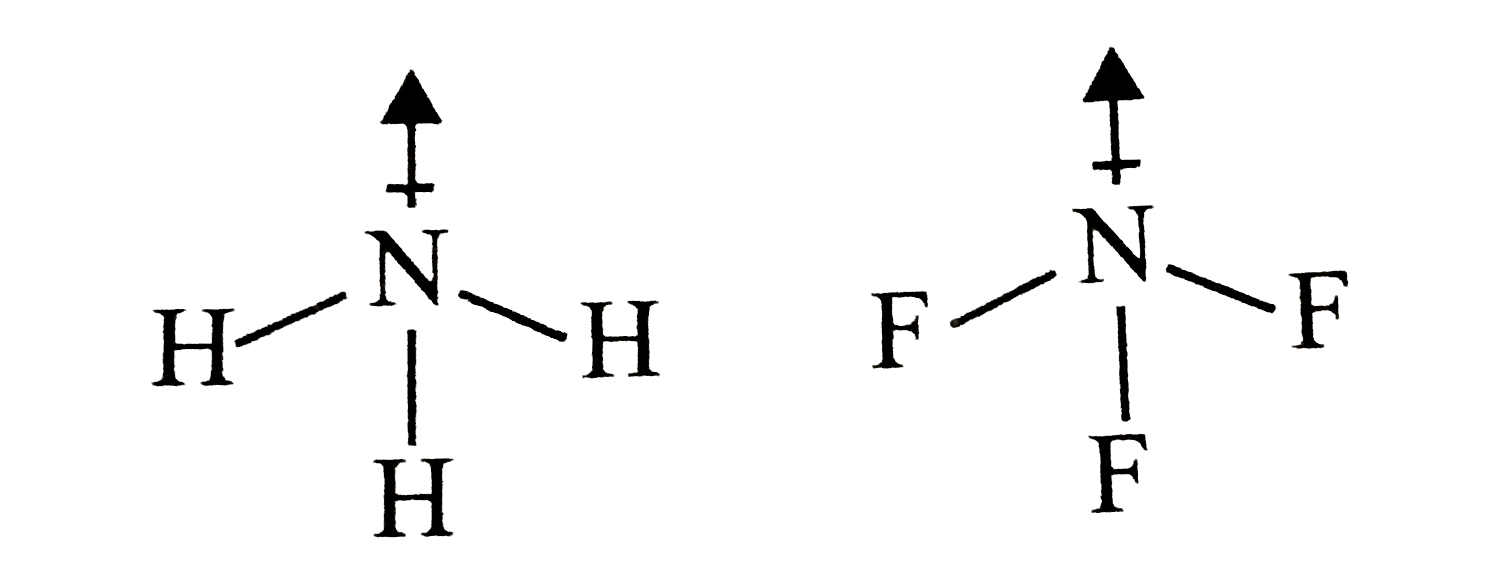Explain why :
dipole moment of H2O is much higher than that of H2S.
To explain why the dipole moment of H₂O is much higher than that of H₂S, we can follow these steps:
1. Understanding Dipole Moment:
- The dipole moment is a measure of the separation of positive and negative charges in a molecule. It is represented by the formula μ=Q×D, where Q is the charge and D is the distance between the charges.
2. Molecular Structures:
- Draw the Lewis structures for both water (H₂O) and hydrogen sulfide (H₂S).
- H₂O has an oxygen atom bonded to two hydrogen atoms, with two lone pairs of electrons on the oxygen.
- H₂S has a sulfur atom bonded to two hydrogen atoms, with two lone pairs of electrons on the sulfur.
3. Electronegativity:
- Identify the electronegativity values of oxygen and sulfur. Oxygen has a higher electronegativity (approximately 3.5) compared to sulfur (approximately 2.5).
- This difference in electronegativity affects the bond polarity.
4. Bond Polarity:
- In H₂O, the O-H bonds are polar due to the significant electronegativity difference between oxygen and hydrogen. This results in a partial negative charge on the oxygen and partial positive charges on the hydrogens.
- In H₂S, the S-H bonds are less polar because the electronegativity difference between sulfur and hydrogen is smaller, resulting in a smaller partial charge.
5. Lone Pairs Contribution:
- The lone pairs on the oxygen in H₂O also contribute to the dipole moment. The dipole moments from the O-H bonds add up vectorially, resulting in a larger net dipole moment.
- In H₂S, the lone pairs on sulfur also create a dipole, but the overall dipole moment is smaller due to the lower bond polarity.
6. Conclusion:
- The combination of higher electronegativity of oxygen, greater bond polarity in H₂O, and the vector addition of dipoles leads to a much higher dipole moment in H₂O compared to H₂S.
Final Answer:
The dipole moment of H₂O is much higher than that of H₂S because of the greater electronegativity difference between oxygen and hydrogen compared to that between sulfur and hydrogen, leading to more polarized bonds in H₂O and a larger net dipole moment.
- The dipole moment is a measure of the separation of positive and negative charges in a molecule. It is represented by the formula μ=Q×D, where Q is the charge and D is the distance between the charges.
- Draw the Lewis structures for both water (H₂O) and hydrogen sulfide (H₂S).
- H₂O has an oxygen atom bonded to two hydrogen atoms, with two lone pairs of electrons on the oxygen.
- H₂S has a sulfur atom bonded to two hydrogen atoms, with two lone pairs of electrons on the sulfur.
- Identify the electronegativity values of oxygen and sulfur. Oxygen has a higher electronegativity (approximately 3.5) compared to sulfur (approximately 2.5).
- This difference in electronegativity affects the bond polarity.
- In H₂O, the O-H bonds are polar due to the significant electronegativity difference between oxygen and hydrogen. This results in a partial negative charge on the oxygen and partial positive charges on the hydrogens.
- In H₂S, the S-H bonds are less polar because the electronegativity difference between sulfur and hydrogen is smaller, resulting in a smaller partial charge.
- The lone pairs on the oxygen in H₂O also contribute to the dipole moment. The dipole moments from the O-H bonds add up vectorially, resulting in a larger net dipole moment.
- In H₂S, the lone pairs on sulfur also create a dipole, but the overall dipole moment is smaller due to the lower bond polarity.
- The combination of higher electronegativity of oxygen, greater bond polarity in H₂O, and the vector addition of dipoles leads to a much higher dipole moment in H₂O compared to H₂S.
The dipole moment of H₂O is much higher than that of H₂S because of the greater electronegativity difference between oxygen and hydrogen compared to that between sulfur and hydrogen, leading to more polarized bonds in H₂O and a larger net dipole moment.
Topper's Solved these Questions
- CHEMICAL BONDING AND MOLECULAR STRUCTUREBOOK - ICSECHAPTER - CHEMICAL BONDING AND MOLECULAR STRUCTUREEXERCISE - OBJECTIVE ( MULTIPLE CHOICE ) TYPE QUESTIONS
81 Videos
- CHEMICAL BONDING AND MOLECULAR STRUCTUREBOOK - ICSECHAPTER - CHEMICAL BONDING AND MOLECULAR STRUCTUREEXERCISE - TRUE OR FALSE TYPE QUESTIONS
25 Videos
- CHEMICAL BONDING AND MOLECULAR STRUCTUREBOOK - ICSECHAPTER - CHEMICAL BONDING AND MOLECULAR STRUCTUREEXERCISE - SHORT ANSWER TYPE QUESTIONS
76 Videos
- CHEMICAL THERMODYNAMICS BOOK - ICSECHAPTER - CHEMICAL THERMODYNAMICS EXERCISE - NCERT TEXT-BOOK. EXERCISES
22 Videos
Similar Questions
Dipole moment of NH3 is more than that of NF3, Explain.
View SolutionDipole moment of H2O2 is non-zero as
View SolutionAlthough F is more electronegative than H, the resultant dipole moment of NH3 is much more than that of NF3. It can be explained as

View SolutionExplain why :
The dipole moment of CO2 is zero although it contains electronegative oxygen atoms.
View SolutionStatement-1: Dipole moment of H2O is more than that of OF2
Statement-2: In H2O , the resultant bond dipole of O-H bond and the resultant lone pair moment are in opposite direction.
View SolutionThe dipole moment of H2O2 is more than that of H2O but H2O2 is not a good solvent because :
View SolutionThe dipole moment of H2O2 is more than that of H2O but H2O2 is not a good solvent because :
View SolutionDipole moment of phenol is smaller than that of methanol. Why ?
View SolutionComment on dipole moment of H2CO3,
View SolutionThe dipole moment of chloroethane is higher than that of chlorobenzene. Explain.
View Solution
